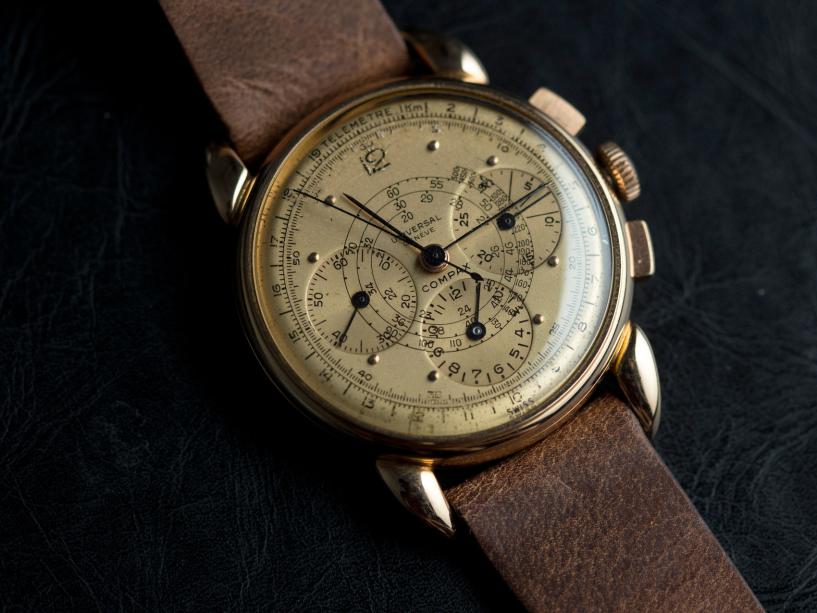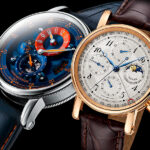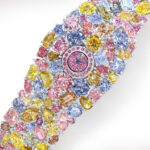We all have our downfalls. That is also true when it comes to once-successful people and big companies. Case in point: the former giant Swiss watch brand called Universal Geneve (UG). In fact, UG used to be one of the hottest brands in the industry. Unfortunately, the Quartz Crisis happened and the brand is not as big now as it was before.
Find out the story behind a watchmaking giant’s influence to horology, its rise to fame, and how it almost plummeted to its doom by reading our primer below.
Universal Geneve History
The Beginnings (1894-1900s)
It all started in 1894 when Numa Emile Descombes and Ulysse Georges Perret decided to join forces. Both of them were talented watchmakers, so it was not surprising that they chose to specialise in making complicated timepieces.
The brand started as an establissage, which means a workshop that assembled different parts of a watch. To put it another way, they had ebauches (movements produced by a third party) delivered to them. Then they do a quality check on these calibres. If those movements pass the inspection, they are fitted inside the case of a watch along with the dial and hands. And it wasn’t long before the duo was able to patent the brand’s first 24-hour indication watch.
Perret & Berthoud
Unfortunately, in 1897, Descombes died. This then made Perret work with Louis Edouard Berthoud. And together, they started to make complete pocket watches and trench watches that were used in World War 1. During this time, they operated under the registered name Perret & Berthoud.
Only a year after Descombes’ death, Berthoud and Perret were able to produce a chronograph with a 30-counter and the Universal Watch Extra. In 1917, they were the first to produce a wrist-worn chronograph. This was a time when men were still getting used to the idea of wearing watches on the wrist. As wristwatches were mainly worn as accessories by ladies.
Universal Watch et Company (UWEC) Genève, Ltd
Despite losing a key person, the brand continued to prosper. And soon, in 1919, the brand moved most of its operations to Geneva, Switzerland. Consequently, they changed their brand name from Perret & Berthoud into Universal Watch et Company (UWEC) Geneve, Ltd.
By 1925, the brand was able to produce its first automatic watch called the Auto Rem. What’s unique about this watch is that it has an octagonal shape. Unfortunately, Ulysee Perret died within a year of the timepiece’s launch. Hence, his son took over the company, which made it a family-run enterprise for decades.
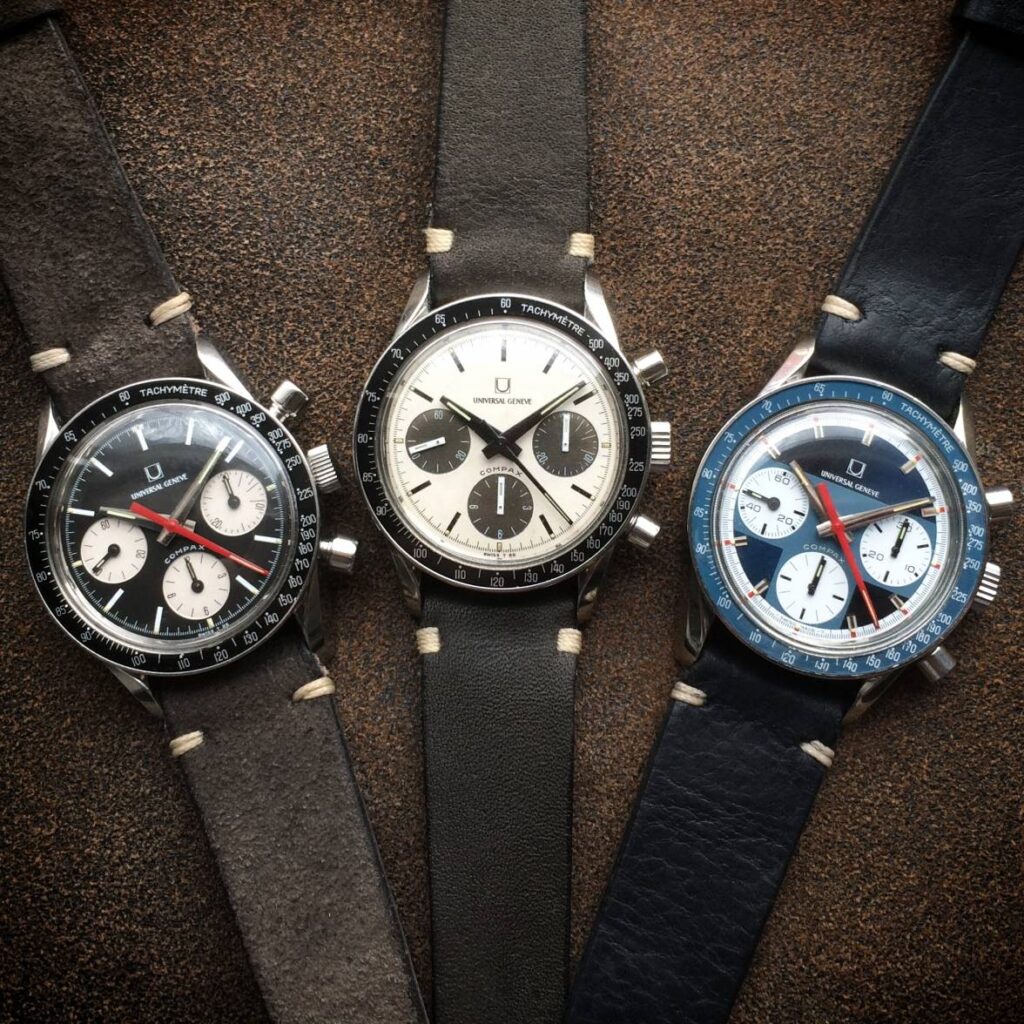
The Rise of Chronograph Watches
During the early 1930s, pocket watches declined in popularity while wristwatches were becoming the norm. People were also starting to favour chronograph watches as their functions were useful to soldiers and civilians alike. With that said, Universal Geneve took this as an opportunity to introduce the Compur during 1933 and the Aero Compax (“Aviator’s Compact Chronograph”) in 1936.
Of the two watches, the Aero Compax became the more popular choice. It featured an automatic “smooth sweep” timekeeping, which people find pleasing to look at even until now. Apart from that, it also had a built-in stopwatch which made it a useful tool for soldiers during training exercises and full-fledged combat operations.
Due to its popularity, Universal Geneve released the Aero Compax in different variations throughout the years. A few of those are the Medico, Moon Phase, Master Vortex, Tri-Compax, and Uni-Compax.
Pour Hermes
Around the same time that the Aero Compax was becoming popular, Universal Geneve partnered with a high fashion brand called Hermes. And while the collaboration was brief, its products played a big role in bringing out the Universal Geneve name to France and other parts of Europe. A good marketing strategy, I would say, as Hermes was, and still is, a big fashion brand.
Together, the two companies designed the Pour Hermes (in English, it translates to “For Hermes”) collection which consisted of different chronographs. But don’t make the mistake of thinking that these are just some fashion-centred watches. In fact, the collection has a lot of features to offer.
The chronographs in the Pour Hermes collection feature square button registers, telemeters and tachometers. In addition, they also used a balance spring from Breguet.
In turn, the Hermes headquarters in Paris became the major sales hub for all Universal Geneve watches in Europe until the 1950s. Meanwhile, the Henri Stern Watch Agency in Manhattan became its official distributor in North America.
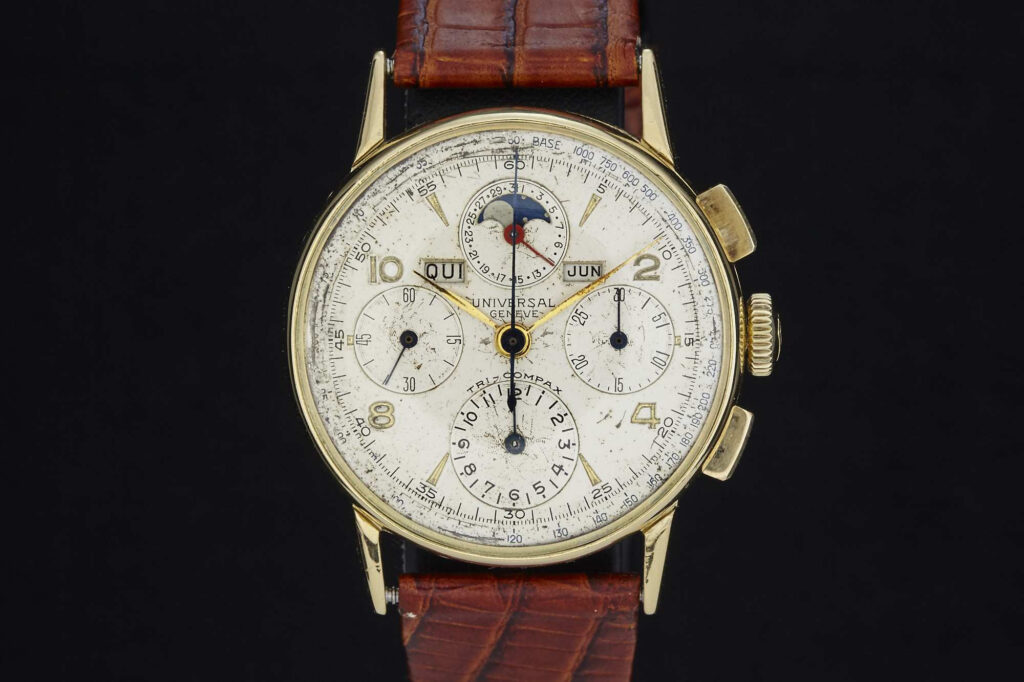
Poor Man’s Patek Philippe
It is important to note that it’s the same distributor that brought Patek Philippe to America so since then, Universal Geneve has been dubbed as the “poor man’s Patek Philippe”. In modern times, people are calling UG watches “poor man’s vintage Patek Philippe”.
But that’s not the only reason why Universal Geneve watches earned that nickname. As mentioned above, the brand released a chronograph called the Tri-Compax. Well, the watch is a lot like the Patek Phillip 1518 without the perpetual calendar. In fact, put them side by side and the resemblance is uncanny.
Universal Geneve in the Government
In time, the popularity and reputation of Universal Geneve grew. In fact, it even caught the attention of various European government officials. Among those patrons are the Dutch Royal Family, who gave Universal Geneve a Royal Warrant in 1939. This allowed the Swiss brand to issue a military watch for the Dutch army.
To make it more special, the military watch featured then-Queen Wilhelmina’s initials embossed on the dial. The Dutch army used this watch up until 1944 when Nazi Germany occupied the Netherlands.
Meanwhile, in that same era, female civilians wore the art deco “Couture Diamond” watch. It featured a mother of pearl dial adorned with diamonds. Universal Geneve also manufactured the model in precious metals like gold or platinum. This was the watch that earned Universal Geneve its title “watch couturier”. In effect, the brand became extremely popular among celebrities, socialites, and wives of world leaders.
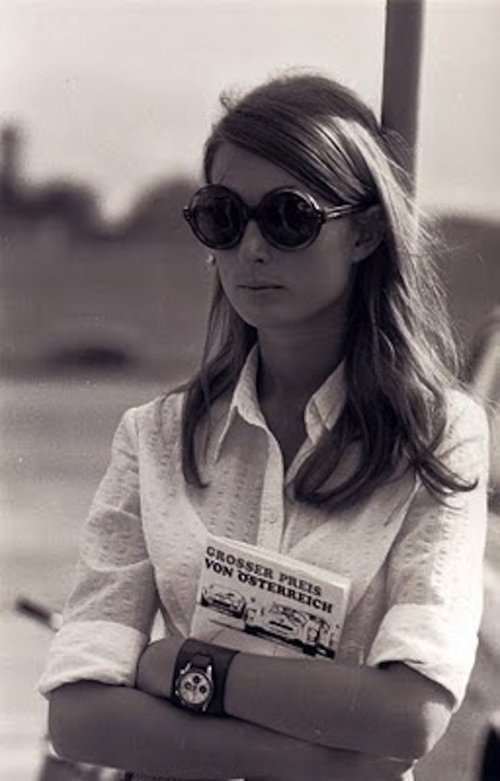
A Watch Fit for a Supermodel
One of the most desirable pieces from Universal Geneve is called the Nina Rindt. It is a classic chronograph from the ’60s that was made famous by a Finnish model who goes by the same name. Furthermore, the brand originally called it the Ref 885103.
To demonstrate, the Nina Rindt has a cream dial with black subdials. In other words, it is what people are fond of calling a “Panda”. Apart from that, it also has a black tachymeter bezel which looks similar to other chronograph models of the era.
Another highly sought-after model is the Evil Nina or officially called the Ref. 885103/01. If truth be told, the Nina Rindt is the yin to the Evil Nina’s yang in terms of aesthetic. As mentioned above, the Ref. 885103 has a cream dial with black subdials. Meanwhile, its counterpart has the colours reversed. It has a black dial with cream subdials.
The famous calibre called Valjoux 72 movement powers both of the models. Furthermore, people consider this calibre a very reliable choice for chronographs in that decade. What’s more interesting is that the Rolex Daytona featured the same movement. You know it’s the real deal when it powers one of the most iconic watches in history!
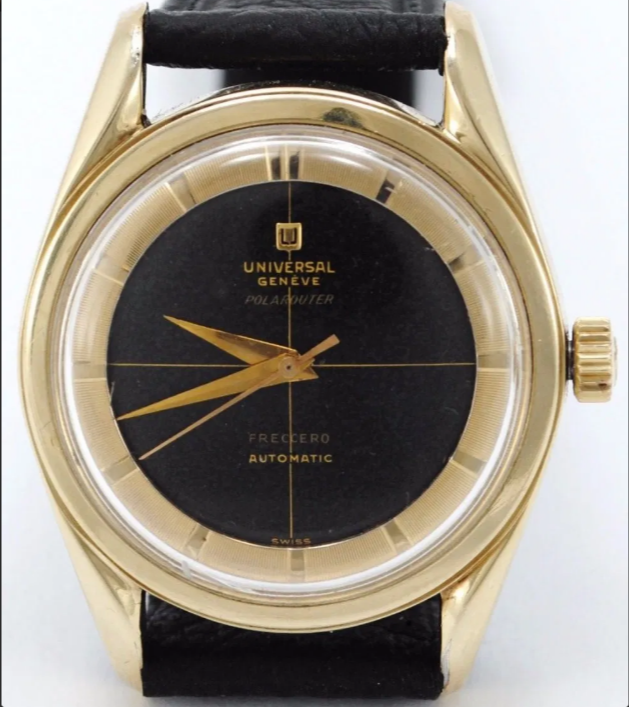
A Collaboration with Gerald Genta
It’s safe to say that a large percentage of watch enthusiasts first heard about Universal Geneve because of the Polerouter. Indeed, the watch in question is fairly easy to obtain and has a long history behind it. Not to mention, famous watch designer Gerald Genta designed it.
Back in 1954, Universal Geneve contacted the young watch designer for a collaboration. During that time, Gerald Genta was not as popular as today. Some people would even say that this project was his big break. He would then go on to design the Patek Philip Nautilus and Audemars Piguet Royal Oak. Both of which are also highly coveted.
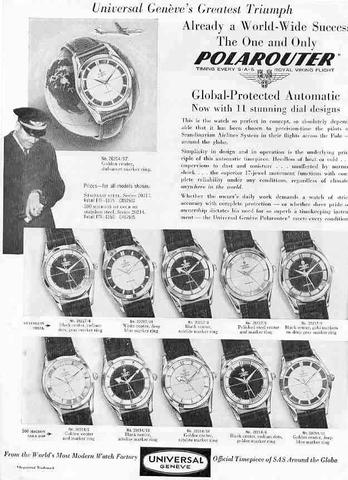
The Watch that Flew over the North Pole
In detail, the task given by Universal Geneve was to design a watch to commemorate the Scandinavian Airline System’s (SAS) flight over the north pole. You have to remember that this was the ’50s when the aviation industry was just beginning to boom so it was considered a breakthrough. The result was the Polarouter which the brand later renamed Polerouter (but still pronounced as “pole-a-router”).
One of the special features of the watch was its resistance to magnetic fields. And after its initial success, Universal Geneve added upgrades like the new calibre 215. People consider this as the first micro-rotor movement. Equally important is the fact that Universal Geneve was one of the first watchmakers that offered mass-produced automatic movements. Consequently, the watches they offered were more affordable. Which is a great reason why Polerouters are great entry points for people who want to get into vintage watches.
Different Polerouter Flavours
Another thing about the Polerouter is that there are many versions of it. Which is a good thing since it means Universal Geneve gave it a lot of upgrades. Additionally, the different flavours of the watch will cater to a lot of different tastes.
One notable version is the Polerouter Sub which UG released in 1961. It is special because it is the only Polerouter model that featured the super compressor case. You can also find that same case in other iconic dive watches from Jaeger-LeCoultre, Longines, and even IWC.
A few other models include the Polerouter de Luxe, Polerouter Jet, the Polerouter Date, and the Polerouter Day-Date. Despite the different variations, a lot of these models feature the unique trapezoid shape, which a lot of watch collectors love.
A Downfall
As written in history books, the Quartz Crisis of the ’70s brought the demise of dozens of watch brands. Particularly the Swiss. And as the popularity of quartz watches grew, the attention for mechanical ones declined. With that said, this took a toll on our beloved Universal Geneve.
But that’s not to say that the Swiss brand gave up without a fight. In fact, they started releasing quartz versions of their watches. In addition, they started focusing their marketing efforts on the Asian watch market since quartz watches originated in Japan.
Despite everything, the venture became a catastrophic blow to the company’s finances. And slowly, the brand slowly crept behind the curtains. As the years went by, the name Universal Geneve became unpopular.
A Brief Comeback
Of course, a big brand like Universal Geneve refuses to completely throw in the towel. After the trying times, a Hong Kong-based investment firm called Stelux Holdings International, Ltd purchased the brand. It is the same group that owns Cyma, another Swiss watchmaker.
During 2001, Universal Geneve made a small comeback. And until now, the brand is still a member of the Federation of the Swiss Watch Industry. They have three offices in Switzerland and they oversee La Chaux-de-Fonds-based watchmaker Cyma.
The bad news is they haven’t produced new models since 2008. In fact, the Universal Geneve website points no clue about future releases.
What’s Next for Universal Geneve?
The future of the brand is hard to say, but of course, a lot of watch enthusiasts are hoping for a reissue of their models. While the brand is quiet, there’s no harm in hoping that their watch engineers and designers are working in their labs. But for now, lovers of vintage watches can whet their appetite by getting the previous models.
Final Notes
Although Universal Geneve is not as popular as it was before, its legacy lives on. There is no denying that the once-popular Swiss watchmaker influenced the watch industry in so many ways. Up to now, its timepieces are still in-demand long after their downfall.
For more Swiss watch brands, check out our review of Chronoswiss!
